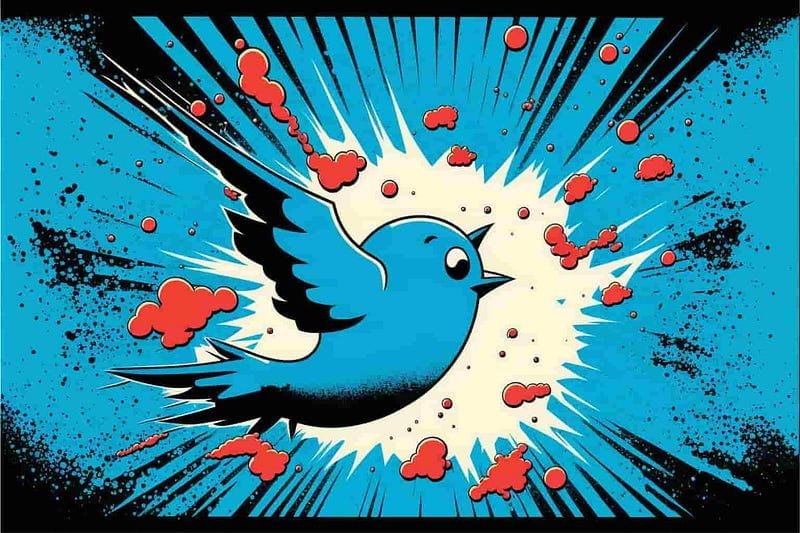Writers Should Prepare for the Downfall of Twitter
It’s time to explore other channels.

Elon Musk’s takeover of Twitter has been a wild ride, to say the least. From laying off 50% of Twitter’s workforce to the growing list of companies that have paused ad spending, it’s unclear what the future holds. And it could take months for the fallout to unravel fully.
For years, writers have depended on Twitter for visibility. Unlike many other social platforms, it is still largely text-based. The #WritingCommunity is known to be a supportive, safe space for writers. We lift each other up, cheer the wins, and commiserate with rejections that are common in the industry.
Yet writers would be remiss not to start thinking about their lives without Twitter. It’s hard, especially for people who have built a large following.
It’s too early to jump ship from Twitter, but writers should prepare for a pivot. If you wait too long, you might find it harder to rebuild elsewhere.
1. Monitor your Twitter engagement
While fellow writers may not leave Twitter immediately, your audience might. And audience is the core of any creator’s livelihood.
Twitter has been flooded with talk of turning to Mastadon or Discord communities. People who are only on Twitter to consume content have less to lose: they’ll start exploring alternatives more quickly.
If you’ve only used Followers as a metric on Twitter in the past, you should start digging into the analytics. Your Follower account may stay the same (since many people won’t bother to deactivate their accounts), but your Impressions and Profile Visits may go down.
Musk has also said that the Twitter algorithm will favor paid Twitter Blue accounts. He’s also floated the idea of Twitter sitting behind a paywall. Like many things, this outcome is unknown, but it’s something to keep in mind.
Start tracking these additional metrics over the next few months. If you see a big dip, it confirms that your reach has been impacted.
2. Double down on other channels
If you have other social channels, start there first. Increase your presence with additional posts and engagement.
While LinkedIn has long been considered a professional/corporate platform, it is increasingly welcoming to creators. But the content is far different than Twitter: it’s more about sharing lessons than self-promotion. Writing posts like “I’ve learned to accept criticism while working with an editor” or “These are marketing takeaways from publishing a book” have a broader appeal.
Instagram is tricky since it doesn’t support purely text posts and increasingly favors videos. Find other successful writers on Instagram and study what they do. A Facebook page gives you more text options, but the company has a similarly uncertain direction. TikTok and YouTube might be an introverted writer’s worst nightmare, but they’re worth looking into.
Medium is still a great place for writers, but long-form and short-form content aren’t the same. Your audience may not read a 1,200-word Medium post (or may not pay for a membership).

3. Capture email addresses
The biggest lesson from Musk’s acquisition of Twitter is that even behemoths can change overnight. You can’t depend on any platform that you don’t control.
Blogs used to be the darling of the internet and a platform you “owned,” but they inherently have a distribution problem.
The most valuable data you can collect? Email addresses.
If you have email addresses, you are forever connected to an audience.
If you build up an audience on TikTok and then some new social platform emerges, you can email your audience and say, “Hey, come find me over here!”
If you select an email platform and in five years that platform feels out-of-date, you can export the email addresses to a new provider.
And the best part? You can capture email addresses and not do anything with them today.
You might feel pressure to start a newsletter or a Substack. Newsletters are a great way to stay in touch with your audience, but they’re a lot of work. (Side Note: Twitter has said it will shut down Revue, its own newsletter platform. So if you’re using Revue, start looking for an alternative.)
I began collecting email addresses months before I did anything with them. I put together a few free products on Gumroad and sent the email addresses from Gumroad downloads to ConvertKit.
4. Find a new community of support
One of the biggest losses from Twitter, if it indeed fizzles into obscurity, will be the #WritingCommunity.
I show up every morning with a #5amwritersclub post. I’m immediately greeted by fellow writers. I would miss that.
A supportive community can be everything to writers, especially new writers. No writer should have to write alone.
Be on the lookout for a Slack or Discord group. Or, if you’re motivated enough, start one and bring your Twitter friends with you.
Stay alert and stay diversified
The advice is everywhere: focus on one platform. Grow there before pursuing another channel.
That made sense from a time management perspective. But writers who only focused on Twitter now find themselves in a tenuous position.
In the end, you need to look out for yourself and protect your livelihood. Whether you write full-time or as a side to your 9–5 job, reaching your audience is everything.
Don’t jump ship from Twitter just yet. But definitely be prepared for fundamental changes in your day-to-day interactions with your audience.
Check out my free guide: 17 Smart Tools Solopreneurs Need to Start, Grow, and Scale.






